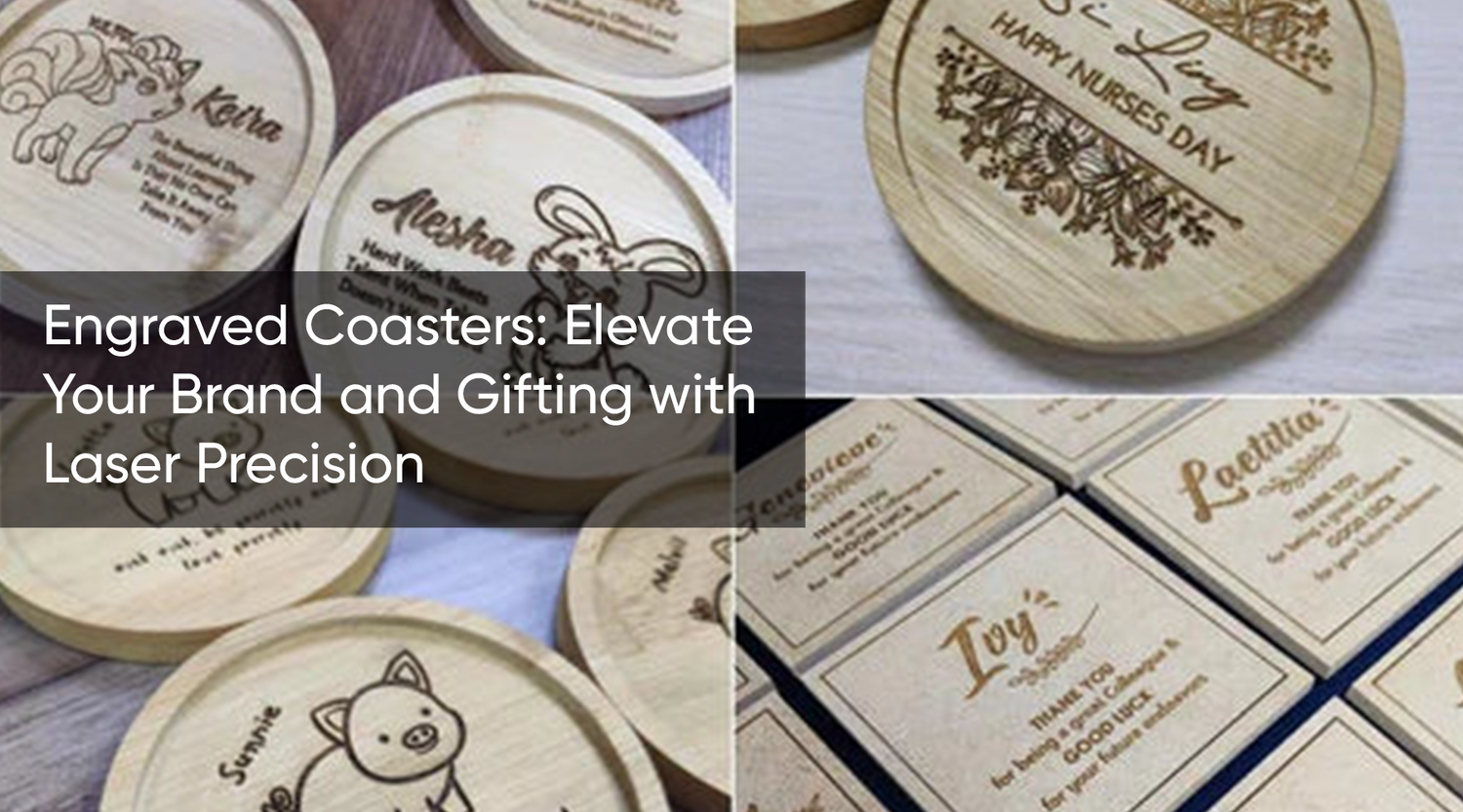So you've got a laser engraving machine or a rotary axis and an idea of what to do with it. Now what? It's all well and good getting that first laser engraving machine and playing with it to etch some polystyrene plates but you'll soon realize that glass laser engraving is not going to be as easy as that.
You need something softer to practice on, so don't worry about your new machine. Playing with a hobby-class tool is not productive for a business. I've decided to answer all questions about glass laser engraving, provide tips, and explain the different methods involved in this article.
What is Laser Glass Engraving?

Laser engraving is a process that uses a laser to etch, or burn, an image into the glass. The resulting image is permanent and can be seen from both sides of the glass.
Glass laser engraving is ideal for creating personalized gifts like wine glasses and photo frames, but you can also use it to make decorative items like vases or bowls. It's easy enough for beginners who want to try their hand at glass etching without investing in expensive equipment or spending hours learning how to use complicated software programs.
There are two major types of lasers used for glass engraving: CO2 laser machines and fiber laser machines. A CO2 laser produces a beam that's invisible to the human eye, but visible in infrared light at 940 nanometers (nm). Fiber lasers produce visible light at 532 nm that's easier for us to see than infrared light. Fiber lasers are more expensive than CO2 lasers but offer higher power density and better beam quality.
Glass laser engraving is a process where the surface of a material (usually glass) is heated by a laser beam, which melts the surface of the material and creates an etching. The depth at which the laser melts depends on how much power is used and how long it's applied.
How to Etch Glass with a Laser Etching Machine?
You don't need any special skills to get started making beautiful, professional-quality laser-etched glass at home. Laser etching is a great way to customize glass engraving items with your own unique designs. Whether you're looking to make wine glasses for your wedding or business logo glasses for your employees, it's an easy way to add some personality to any glassware. In this article, we'll explore everything from what laser glass engraving is and how it works, and some mistakes that need to avoid.
Clean the Glass
Before you begin laser etching, it's important to make sure your glass is clean and free of oils. You can use a mild detergent or soap, like dishwashing liquid, to remove any residue on the surface of the glass. Be sure not to get any water into the laser cutter while cleaning it--this could damage its components!
Masking Tape or Painter's Tape
Once you've cleaned off all visible dirt and grime from your piece of glass (and perhaps even wiped down its edges), cover up any areas that don't need etched with masking tape or painter's tape so they don't get accidentally etched away during the glass laser engraving process.
If there are any sharp corners or edges where pieces may overlap each other when stacked together later on in assembly after etching has been completed successfully without damaging anything else around them due to overlapping onto another piece instead; simply trim them off beforehand using scissors so there won't be any chance for damage occurring during stacking later on down the line when assembling multiple pieces together after being etched separately first individually before combining all together at once.
Use the Right Settings
When you're engraving glass, it's important to use the right settings for your glass engraver. The best way to do this is by starting with a low power setting and slowly increasing it until you reach an appropriate level for your material. If you use too much power or don't adjust the setting correctly before starting your project, there's a chance that the glass will break or crack during the process--and we don't want that!
Adjusting laser power isn't just about finding out what works best; it also helps prevent accidents from happening while working with lasers (which are dangerous!). If there's too much energy hitting one area of glass at once, then there could be some issues down line with melting points being exceeded--which could lead to some serious safety concerns later on downline if left unchecked.
Finishing Touches
After you've etched your glass, it's time to polish it. This will help smooth out any rough edges and give your design a nice finish.
Next, apply a protective coating to keep the etching from fading over time. If you want to preserve the etched design for many years without having it fade or wear off, use a UV-cured resin coating (it takes about 30 minutes). If not, acrylic varnish will work just fine--but remember that it won't protect against water damage!
Laser etched wine glasses with a rotary axis

The rotary axis is an important part of any CNC machine because it allows you to move parts around in three dimensions while keeping them stationary at all other points in space (X Y Z). In this case, we're using your laser engraver with rotary attachment to rotate our wine glasses around their vertical axis while keeping them stationary vertically (Y) in the CO2 laser engraver. For fiber laser machines, you need a 3 jaws rotary axis.
The next step is to bring your gantry slowly, so you do not activate the motors of the computers inside, and on the back corner is your Y cable, you are going to unplug that screw and then pop it out, now that the Y cable port is unscrewed, you can then move your gantry back a little bit place in your rotary.
When installing the rotary, all Monport laser machines need to link the rotary to the y-axis, and also need to lower the laser bed to the appropriate position.
Unlike the general K40 lasers, the laser bed of the Monport 40W CO2 laser can be removed, and it is very convenient to install the rotary. For Monport 60W, you need to manually lower the bed. Monport 80W and above can automatically lift and down the laser bed.
FAQ: Glass Laser Engraving & Glass Laser Etching
1. What machine is best for laser etching glass?
A CO2 glass etching machine is the most common choice for smooth, frosted engravings on glass. Fiber lasers can also be used for glass laser marking, but CO2 machines generally deliver cleaner, more consistent surface etching.
2. Can any laser engrave glass?
No. Only lasers designed for glass—such as CO2 systems or certain fiber lasers—can safely perform glass laser etching. Hobby lasers often lack the power and precision needed for clean results.
3. What is the difference between glass laser engraving and laser marking?
Laser etched glass creates a frosted, textured surface by micro-fracturing the material.
Glass laser marking is shallower and focuses more on precise, high-contrast surface marking, often used for barcodes, logos, or serial numbers on industrial glass products.
4. Can I use an etching machine for cylindrical items like wine glasses?
Yes. When paired with a rotary axis, an etching machine for glass can engrave wine glasses, tumblers, bottles, and other curved items. The rotary attachment keeps the glass rotating smoothly during the marking process.
5. Why does glass sometimes crack during laser engraving?
Cracking occurs when the laser power is too high, the speed is too slow, or the glass contains impurities. Using proper settings and high-quality glass engraving equipment helps prevent thermal stress and microfractures.
6. Do I need special coatings for laser etched glass?
Not necessarily. However, applying a temporary coating like dish soap or masking tape can help diffuse heat and protect the surface during glass laser etching—especially on thin or delicate glass.
7. What settings should I use when engraving glass?
Settings vary by machine, but the general rule is:
-
Low power
-
High speed
-
Multiple passes if needed
This reduces heat buildup and results in smoother laser etched glass.
8. Can I engrave colored or tempered glass?
Colored glass works well, but tempered glass is not recommended for standard CO2 engraving. The internal stress of tempered glass can cause it to shatter when exposed to heat from a glass etching machine.
9. What types of designs can be laser-etched onto glass?
Anything from logos and monograms to full photo engravings. Modern glass engraving equipment supports high-resolution images, vector graphics, text, patterns, and custom artwork.
10. Does laser engraving weaken glass?
Surface etching slightly alters the top layer but typically does not affect structural strength. The effect is similar to sandblasting, but glass laser etching is more controlled and precise.
11. What is the best laser engraver for detailed photo engraving on glass?
A CO2 laser with fine spot size and stable power output is ideal. Paired with proper settings, it can achieve high-detail patterns and photo-realistic laser etched glass.
12. Can I start a business using a glass etching machine?
Absolutely. Items like custom wine glasses, awards, barware, and gifts are profitable niches. Modern glass laser marking technology makes it easy to produce professional-quality results even for beginners.
Conclusion
In this guide, we've covered the basics of glass laser engraving. As you can see, it's an easy process that doesn't require much equipment or experience. If you're interested in getting started with glass laser engraving and want to try your hand at it yourself.
Get your Monport Canada laser engraver discount—enter code MPideas10 at checkout or tap the code at the top of the page.






